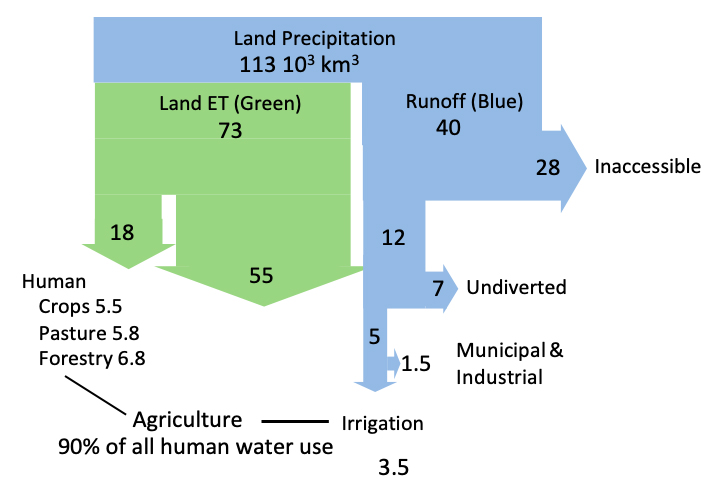This class begins by considering the demands placed on global and regional water supplies. The key concept behind the analysis is the hydrologic cycle, which is briefly discussed in S6. Postel et al. (1996) estimate average annual global fresh water fluxes for the portions of the hydrologic cycle most relevant to human uses of water (see attached figure below). They show that agriculture uses much more water than the municipal and industrial sectors, both globally and at river basin scales. However, the agricultural water is a small fraction of the total water passing through the landscape, with most precipitation over land going to evapotranspiration from natural vegetation and to runoff to the ocean.

Based on Postel (1996), Rost (2008), and FAO (2014).
Rosa et al. (2020) consider the impacts of spatial and temporal variations in the demand and availability of water that are not included in the global average analysis of Postel et al. (1996). These variations lead to local water scarcity, which occurs when the demand for water at a given time and place exceeds the supply. Rosa et al. (2020) identify different types of water scarcity, relying on the concepts of blue and green water discussed in S6. Green water is local rainfall that is stored as soil moisture and can be taken up by terrestrial plants. Much of it is subsequently lost to evapotranspiration. Blue water originates from rainfall that flows through rivers, lakes, and aquifers, where it can be withdrawn for human uses. When the available green water is not sufficient to meet the needs of a particular crop blue water can be used to make up the soil moisture deficit through irrigation. Irrigation effectively transfers water from runoff to crop evapotranspiration (i.e. from blue to green water), modifying the natural water cycle.
Rosa et al. (2020) use model-generated water scarcity indices to show where and when various types of scarcity occur. Their analysis indicates that irrigation withdrawals are unsustainable (i.e. are depleting freshwater reserves) on a global scale. However, some agricultural areas that are chronically water short have the potential for locally sustainable increases in irrigation but do not have the economic resources to develop the required infrastructure. This finding suggests that better management and planning of irrigation development could provide sustainable improvements in water and food security.
The uneven distribution of water resources has put significant stress on limited surface and groundwater resources in areas that are currently heavily populated, such as China and India. Water stresses are likely to increase in areas where population is growing rapidly, particularly in Africa and parts of central Asia. Hertig and Gleeson (2012) focus on the use of groundwater resources, which are particularly important sources for irrigation water in arid and semi-arid regions. They cite a number of references that document the widespread occurrence of groundwater depletion in important agricultural regions, especially in North America and Asia. Overall, the readings in this class indicate that spatial and temporal variability greatly complicate our ability to determine whether there is enough readily available water to support a significant expansion in agricultural production.
Required Readings
Human Appropriation of Water
- Sandra L. Postel, Gretchen C. Daily, and Paul R. Ehrlich. 1996. “Human Appropriation of Renewable Fresh Water.” Science. 271, no. 5250: 785–788.
Distribution of Water Resources
- Lorenzo Rosa, Davide Danilo Chiarelli, et al. 2020. “Global Agricultural Economic Water Scarcity.” Science Advances. 6, no. 18: eaaz6031.
Groundwater Depletion
- Werner Aeschbach-Hertig and Tom Gleeson. 2012. “Regional Strategies for the Accelerating Global Problem of Groundwater Depletion.” Nature Geoscience. 5: 853–861.
Optional Readings
Water Scarcity
- Frank Rijsberman, 2006. “Water Scarcity: Fact or Fiction?” Agricultural Water Management. 80, no. 1–3: 5–22.
Water Storage Trends
- M. Rodell, J.S. Famiglietti, et al. 2018. “Emerging Trends in Global Freshwater Availability.” Nature. 557, no. 7707: 651–659.
Groundwater Depletion
- Yoshihide Wada, Ludovicus P.H. Van Beek, et al. 2010. “Global Depletion of Groundwater Resources.” Geophysical Research Letters. 37, no. 20.
Discussion Points
- How would you answer the question: “Are we running out of water” (for food production)?
- What more would you need to know to determine if it is feasible to reduce global water consumption to sustainable levels while satisfying the food demands of growing populations in water scarce regions?










